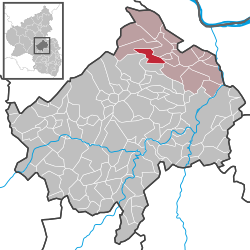Schöneberg (Hunsrück)
| Schöneberg | ||
|---|---|---|
|
||
| Coordinates: 49°55′24″N 07°45′18″E / 49.92333°N 7.75500°ECoordinates: 49°55′24″N 07°45′18″E / 49.92333°N 7.75500°E | ||
| Country | Germany | |
| State | Rhineland-Palatinate | |
| District | Bad Kreuznach | |
| Municipal assoc. | Stromberg | |
| Government | ||
| • Mayor | P. Salz | |
| Area | ||
| • Total | 7.13 km2 (2.75 sq mi) | |
| Elevation | 345 m (1,132 ft) | |
| Population (2015-12-31) | ||
| • Total | 608 | |
| • Density | 85/km2 (220/sq mi) | |
| Time zone | CET/CEST (UTC+1/+2) | |
| Postal codes | 55444 | |
| Dialling codes | 06724 | |
| Vehicle registration | KH | |
| Website | www.schöneberg-hunsrück.de | |
Schöneberg is an Ortsgemeinde – a municipality belonging to a Verbandsgemeinde, a kind of collective municipality – in the Bad Kreuznach district in Rhineland-Palatinate, Germany. It belongs to the Verbandsgemeinde of Stromberg, whose seat is in the like-named town. Schöneberg is a winegrowing village.
Schöneberg lies in the Hunsrück on a mountain ridge in the Soonwald between the Guldenbach and Gräfenbach valleys, roughly 10 km southwest of the River Rhine at Bingerbrück.
Clockwise from the north, Schöneberg’s neighbours are the municipality of Dörrebach, the town of Stromberg, and the municipalities of Schweppenhausen, Windesheim, Hergenfeld and Spabrücken, all of which likewise lie within the Bad Kreuznach district. Owing to a peculiarity in the way in which the municipal boundaries are laid out, the village site of Eckenroth, whose municipal area does not border on Schöneberg’s, actually lies nearer the village site of Schöneberg than the village site of Schweppenhausen does.
As far back as ancient times, the place where Schöneberg now lies was being used by Romans as an important way station. Proof of this comes from, among other things, the foundations of a villa rustica with a hypocaust, which were unearthed in the course of building work. The military road running by Schöneberg from Kreuznach to Koblenz later served postal coach traffic. Schöneberg thus had regular links to other places by way of the Thurn und Taxis postal riders as an Ordinari Postort, a regular stop. In 983, the village passed from Imperial ownership to the Archfoundation of Mainz and was later granted to various knightly families. A man with a link to the village, Johann von Schönenberg, even became the Archbishop-Elector of Trier and the instigator of the Trier witch trials. The von Schonenburg lordly family built the first castle house in 1539, on whose foundations their descendants built a newer one that still stands today in 1686. The earlier house had also been Johann von Schönenberg’s childhood home. Later, the village passed to the Palatinate, who enfeoffed the Counts of Ingelheim with it. This lordship ended when French Revolutionary troops came marching into the region.
...
Wikipedia



